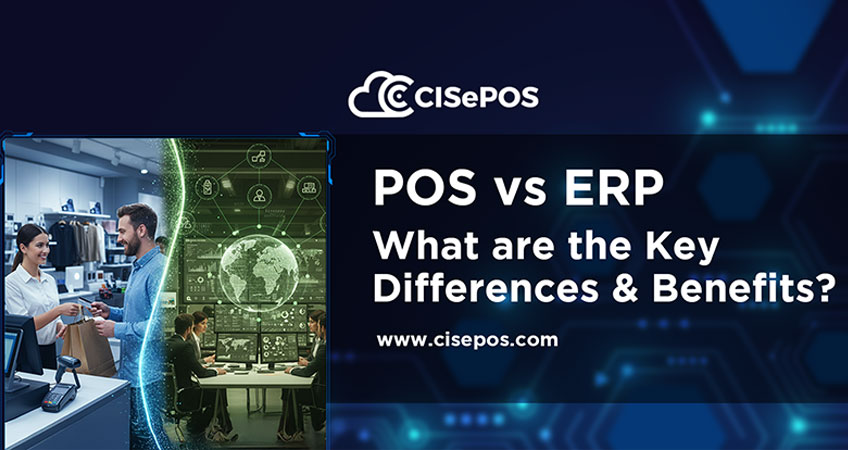
The terms Enterprise Resource Planning (ERP) and Point of Sale (POS) are commonly used in technology. They are also part of professional vocabulary. Both terms have also been interchangeably. But they both differ in purpose, and scope.
Both systems are essential for modern businesses. However, they both serve fundamentally different functions that can either make or break a company’s operational efficiency. Here is how POS vs ERP can be briefly explained:
- A POS system is the central system of front-end operations. The tool businesses use to process sales and handle daily transactions
- An ERP system is the nerve center of an organization. It integrates each department function (from inventory and finance to marketing, supply chain, etc.) into an individual and unified platform
Understanding essential differences between these two systems is the first step in creating a business that is not only profitable but also streamlined.
Understanding an ERP System
An Enterprise Resource Planning (ERP) system is a full-fledged software solution. It integrates all aspects of a company’s operations and covers numerous functions and tasks, mainly:
- Managing financial data
- Invoices
- Payroll
- Human resource functions
- Supply chain management
- Inventory checkup
- Logistics
POS systems primarily focus on sales, whereas ERP systems encompass a broader range of functions. The latter centralizes data from all departments. Thus ensuring that everyone can access reliable and accurate information.
For instance, an automotive company might use one to track the shipment, production, testing, and final delivery of automobiles to customers and dealerships. All this is done using a single platform.
How does an ERP system work?
An ERP system comprises business applications and integrated module solutions. They both share a common database that connects them and lets them work seamlessly. Each module of an ERP focuses on one business area. Yet they all work together using the same data to fulfill organizational requirements.
The components of an ERP system depend on an organization’s requirements. Yet, there are key features that are already pre-included in it, and they include the following:
- Finance
- Customer relationship management
- Human resources
- Logistics and production
- Supply chain management
Understanding the advantages of ERP
- Improving customer service
- Customized reporting
- Widespread cooperation
- More sustainability
- Improvement of transparency with greater insights
- Increased flexibility and scalability
- Increased productivity
- Saving costs via the removal of redundant processes
- Standardizing business processes
Understanding a POS System
A Point of Sale (POS) system is typically found in restaurants, physical and online retail platforms. They serve as the interface where transactions take place. Businesses use them to quickly and efficiently process payments. Shops, restaurants and other retail establishments use them for payment collection too.
How POS system works?
A POS system carries numerous key tasks and functions. It manages inventory by tracking stock levels in real-time. This helps businesses avoid running out of products and ensures everything is recorded promptly.
A POS system also provides detailed reports on daily business operations. It provides analytics that spot trends and help business owners make intelligent decisions. Moreover, they also process payments via various methods especially:
- Debit/credit cards
- Cash transfers
- Digital wallets
Understanding the advantages of POS system
- Better customer service
- Valuable insights
- Increased business efficiency
- Improved multi-store and inventory management
- More options for flexibility in payments
Understanding the difference between ERP and POS
The debate between POS vs ERP can be further clarified by examining the key differences between these two. Both systems have differences between each other. Now is the time we briefly explore them in the following table:
| Key Features | POS Systems | ERP Systems |
|---|---|---|
| Purpose | Manages transactions at the point-of-sale (POS) | It handles overall business and organizational processes in an organization |
| Users | This system is primarily used by restaurants and retailers | An ERP system is utilized by large organizations that have numerous functions |
| Data Management | This system tracks sales data | It integrates sales with finance, HR, and supply chain. Data and information are also tracked and shared |
| Price | Generally affordable thanks to subscription models | This software is a long-term investment |
Integrating an ERP and POS – how they can work together
Integrating the POS system with an ERP solution can significantly enhance operations. Sales data from the former can reflect in the latter once both are connected. Manual entry is removed. This undoubtedly eliminates errors.
This integration allows real-time access to customer information and purchase history. It helps companies make the right decisions based on correct recommendations. Hence, the availability of real-time data is of great use in this matter.
Let us consider the example of a retail store with multiple locations. They can use a POS for daily transactions and rely on an ERP software for flawless accounting, inventory management, and business operations. Thus it creates seamless operations across multiple stores.
Selecting the right system for the business
Each business should consider its requirements first before it decides between a POS vs ERP system. The former helps retail companies manage sales transactions. The latter should be chosen if companies require a comprehensive solution covering multiple functions.
Some companies benefit from using both systems together. Hence, this creates a hybrid approach using the best of both systems.
Over to You
One thing is clear in the debate between a POS vs ERP system: both are inherently different. The former supports businesses with a core focus on retail. Whereas, the latter is preferred by companies with multiple functions requiring a unified platform to keep them together.
Choosing between these two systems is not hard. Companies need to give due consideration to their requirements to get the software system they need. Then they can work seamlessly to produce the best outcomes.


